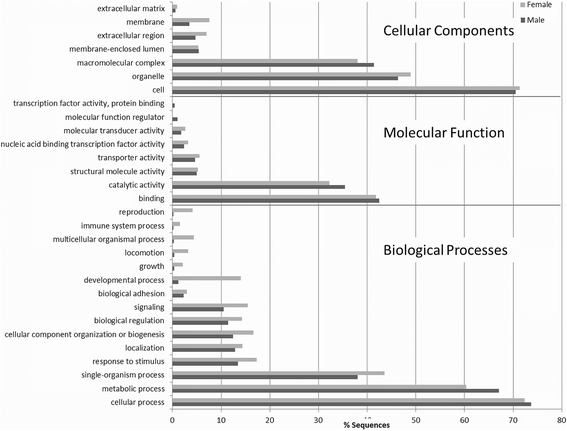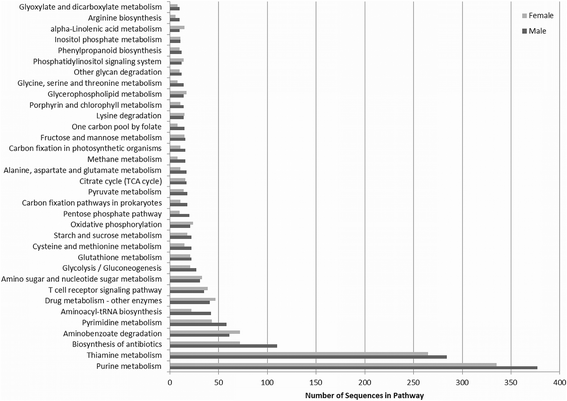Genome sequence of Phormia regina Meigen (Diptera: Calliphoridae): implications for medical, veterinary and forensic research
- PMID: 27793085
- PMCID: PMC5084420
- DOI: 10.1186/s12864-016-3187-z
Genome sequence of Phormia regina Meigen (Diptera: Calliphoridae): implications for medical, veterinary and forensic research
Abstract
Background: Blow flies (Diptera: Calliphoridae) are important medical, veterinary and forensic insects encompassing 8 % of the species diversity observed in the calyptrate insects. Few genomic resources exist to understand the diversity and evolution of this group.
Results: We present the hybrid (short and long reads) draft assemblies of the male and female genomes of the common North American blow fly, Phormia regina (Diptera: Calliphoridae). The 550 and 534 Mb draft assemblies contained 8312 and 9490 predicted genes in the female and male genomes, respectively; including > 93 % conserved eukaryotic genes. Putative X and Y chromosomes (21 and 14 Mb, respectively) were assembled and annotated. The P. regina genomes appear to contain few mobile genetic elements, an almost complete absence of SINEs, and most of the repetitive landscape consists of simple repetitive sequences. Candidate gene approaches were undertaken to annotate insecticide resistance, sex-determining, chemoreceptors, and antimicrobial peptides.
Conclusions: This work yielded a robust, reliable reference calliphorid genome from a species located in the middle of a calliphorid phylogeny. By adding an additional blow fly genome, the ability to tease apart what might be true of general calliphorids vs. what is specific of two distinct lineages now exists. This resource will provide a strong foundation for future studies into the evolution, population structure, behavior, and physiology of all blow flies.
Keywords: Blow fly; Calliphoridae; Genome; Phormia regina; Sex determination; X chromosome; Y chromosome.
Figures




Similar articles
-
Blow Flies (Diptera: Calliphoridae) and the American Diet: Effects of Fat Content on Blow Fly Development.J Med Entomol. 2022 Jul 13;59(4):1191-1197. doi: 10.1093/jme/tjac040. J Med Entomol. 2022. PMID: 35488843
-
Competition Among Three Forensically Important Blow Fly Species (Diptera: Calliphoridae): Phormia regina, Lucilia sericata, and Chrysomya rufifacies.Environ Entomol. 2020 Dec 14;49(6):1473-1479. doi: 10.1093/ee/nvaa120. Environ Entomol. 2020. PMID: 33030207
-
Impact of Comingled Heterospecific Assemblages on Developmentally Based Estimates of the Post-Mortem Interval-A Study with Lucilia sericata (Meigen), Phormia regina (Meigen) and Calliphora vicina Robineau-Desvoidy (Diptera: Calliphoridae).Insects. 2021 Mar 25;12(4):280. doi: 10.3390/insects12040280. Insects. 2021. PMID: 33805865 Free PMC article.
-
Sex determination mechanisms in the Calliphoridae (blow flies).Sex Dev. 2014;8(1-3):29-37. doi: 10.1159/000357132. Epub 2013 Dec 21. Sex Dev. 2014. PMID: 24401179 Review.
-
The development of the black blow fly, Phormia regina (Meigen).Forensic Sci Int. 2001 Aug 15;120(1-2):79-88. doi: 10.1016/s0379-0738(01)00431-5. Forensic Sci Int. 2001. PMID: 11457615 Review.
Cited by
-
HOFE: an interactive forensic entomological database.Database (Oxford). 2024 Jul 13;2024:baae058. doi: 10.1093/database/baae058. Database (Oxford). 2024. PMID: 39001614 Free PMC article.
-
Exogenous and endogenous microbiomes of wild-caught Phormia regina (Diptera: Calliphoridae) flies from a suburban farm by 16S rRNA gene sequencing.Sci Rep. 2019 Dec 30;9(1):20365. doi: 10.1038/s41598-019-56733-z. Sci Rep. 2019. PMID: 31889104 Free PMC article.
-
Unraveling forensic timelines using molecular markers in Phormia regina maggots.bioRxiv [Preprint]. 2025 May 7:2025.04.30.651557. doi: 10.1101/2025.04.30.651557. bioRxiv. 2025. PMID: 40654918 Free PMC article. Preprint.
-
Chromosomal-level reference genome of Chinese peacock butterfly (Papilio bianor) based on third-generation DNA sequencing and Hi-C analysis.Gigascience. 2019 Nov 1;8(11):giz128. doi: 10.1093/gigascience/giz128. Gigascience. 2019. PMID: 31682256 Free PMC article.
-
Chromosome-level genome assembly of Aldrichina grahami, a forensically important blowfly.Gigascience. 2020 Mar 1;9(3):giaa020. doi: 10.1093/gigascience/giaa020. Gigascience. 2020. PMID: 32191812 Free PMC article.
References
Publication types
MeSH terms
LinkOut - more resources
Full Text Sources
Other Literature Sources
Miscellaneous

